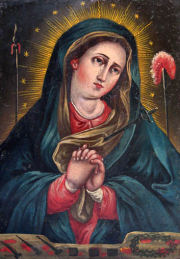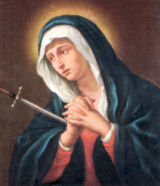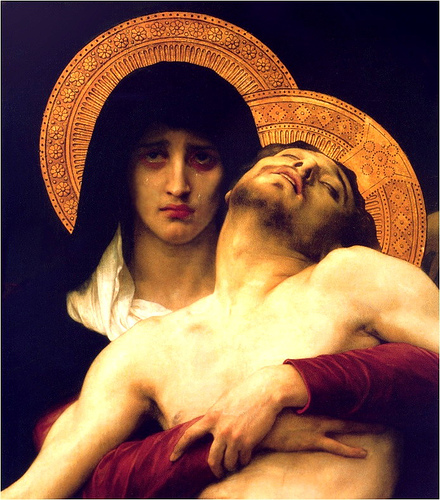----- Forwarded Message -----
From: Nivard . . . . . .
Cc: [7]. . . . . . . .
Sent: Wednesday, 21 August 2013, 17:07
Subject: Mary's Queenship
Cc: [7]. . . . . . . .
Sent: Wednesday, 21 August 2013, 17:07
Subject: Mary's Queenship
|
| ||
|
| ||||||
|
 |
| An icon of the Theotokos, the Mother of God. Egg tempera on wood, Central Russia, mid-1800's. |
Month of the Seven Sorrows of Mary
The month of September (Overview - Calendar) is dedicated to the Seven Sorrows of Mary. Devotion to the sorrows of the Virgin Mary dates from the twelfth century, when it made its appearance in monastic circles under the influence of St. Anselm and St. Bernard. The Cistercians and then the Servites undertook to propagate it. It became widespread in the fourteenth and especially the fifteenth centuries, particularly in the Rhineland and Flanders, where Confraternities of the Sorrowful Mother sprang up. It was in this context that the first liturgical formularies in her honor were composed. A provincial council of Mainz in 1423 made use of these in establishing a "Feast of the Sorrows of Mary" in reparation for Hussite profanations of her images.
In 1494 the feast appeared in Bruges, where the Precious Blood of Christ was venerated; later on it made its way into France. It did not, however, become widespread in France before Benedict XIII included it in the Roman Calendar in 1727 and assigned it to the Friday before Palm Sunday.
Some Churches had previously celebrated this feast during the Easter season. Others, however, celebrated the Joys of the Blessed Virgin during the Easter season, as is still done today at Braga. In some places it was entitled "Recollection of the Feasts and Joys of the Blessed Virgin Mary."
Excerpted from The Church at Prayer, Vol. IV A.G. Martimort.
Fr. Faber on the Seven Sorrows
 God vouchsafed to select the very things about Him which are most incommunicable, and in a most mysteriously real way communicate them to her. See how He had already mixed her up with the eternal designs of creation, making her almost a partial cause and partial model of it. Our Lady's co-operation in the redemption of the world gives us a fresh view of her magnificence. Neither the Immaculate Conception nor the Assumption will give us a higher idea of Mary's exaltation than the title of co-redemptress. Her sorrows were not necessary for the redemption of the world, but in the counsels of God they were inseparable from it. They belong to the integrity of the divine plan. Are not Mary's mysteries Jesus' mysteries, and His mysteries hers? The truth appears to be that all the mysteries of Jesus and Mary were in God's design as one mystery. Jesus Himself was Mary's sorrow, seven times repeated, aggravated sevenfold. During the hours of the Passion, the offering of Jesus and the offering of Mary were tied in one. They kept pace together; they were made of the same materials; they were perfumed with kindred fragrance; they were lighted with the same fire; they were offered with kindred dispositions. The two things were one simultaneous oblation, interwoven each moment through the thickly crowded mysteries of that dread time, unto the eternal Father, out of two sinless hearts, that were the hearts of Son and Mother, for the sins of a guilty world which fell on them contrary to their merits, but according to their own free will. God vouchsafed to select the very things about Him which are most incommunicable, and in a most mysteriously real way communicate them to her. See how He had already mixed her up with the eternal designs of creation, making her almost a partial cause and partial model of it. Our Lady's co-operation in the redemption of the world gives us a fresh view of her magnificence. Neither the Immaculate Conception nor the Assumption will give us a higher idea of Mary's exaltation than the title of co-redemptress. Her sorrows were not necessary for the redemption of the world, but in the counsels of God they were inseparable from it. They belong to the integrity of the divine plan. Are not Mary's mysteries Jesus' mysteries, and His mysteries hers? The truth appears to be that all the mysteries of Jesus and Mary were in God's design as one mystery. Jesus Himself was Mary's sorrow, seven times repeated, aggravated sevenfold. During the hours of the Passion, the offering of Jesus and the offering of Mary were tied in one. They kept pace together; they were made of the same materials; they were perfumed with kindred fragrance; they were lighted with the same fire; they were offered with kindred dispositions. The two things were one simultaneous oblation, interwoven each moment through the thickly crowded mysteries of that dread time, unto the eternal Father, out of two sinless hearts, that were the hearts of Son and Mother, for the sins of a guilty world which fell on them contrary to their merits, but according to their own free will.
— Fr. Frederick Faber, The Foot of the Cross.
| 
Thou, Mother, dying in so many ways, pierced by such dreadful sorrows, didst not die.

Prayer of the Month
Prayer of St. Bonaventure
Lady, who by thy sweetness dost ravish the hearts of men, hast thou not ravished mine? O ravisher of hearts, when wilt thou restore me mine? Rule and govern it like thine own; preserve it in the Blood of the Lamb, and place it in thy Son's side. Then shall I obtain what I desire, and possess what I hope for; for thou art our hope.
Documents
Websites
|
Treasures of the Church- Devotions
|

1. When the time came for their purification according to the law of Moses, they brought him up to Jerusalem to present him to the Lord
2. Now there was a man in Jerusalem, whose name was Simeon, and the Holy Spirit was upon him.
3. He took Jesus up in his arms and blessed God and said, "Lord, now let thy servant depart in peace, according to thy word;
4. for mine eyes have seen thy salvation which thou hast prepared in the presence of all peoples.
5. And his father and his mother marveled at what was said about him;
6. and Simeon blessed them and said to Mary his mother, "Behold, this child is set for the fall and rising of many in Israel, and for a sign that is spoken against"
7. (and a sword will pierce through your own soul also), that thoughts out of many hearts may be revealed."
1. When the Magi had departed, behold, an angel of the Lord appeared to Joseph in a dream
2. He said, "Rise, take the child and his mother, and flee to Egypt, and remain there till I tell you; for Herod is about to search for the child, to destroy him."
3. Joseph rose and took the child and his mother by night, and departed to Egypt, and remained there until the death of Herod.
4. Then Herod, when he saw that he had been tricked by the wise men, was in a furious rage.
5. He sent and killed all the male children in Bethlehem and in all that region who were two years old or under.
6. But when Herod died, behold, an angel of the Lord appeared in a dream to Joseph in Egypt.
7. "Rise, take the child and his mother, and go to the land of Israel, for those who sought the child's life are dead." And he rose and took the child and his mother, and went to the land of Israel.
1. Now his parents went to Jerusalem every year at the feast of the Passover. And when he was twelve years old, they went up according to custom;
2. When the feast was ended, as they were returning, the boy Jesus stayed behind in Jerusalem.
3. His parents did not know it, but supposing him to be in the company they went a day's journey,
4. They sought him among their kinsfolk and acquaintances; and when they did not find him, they returned to Jerusalem, seeking him.
5. After three days they found him in the temple, sitting among the teachers, listening to them and asking them questions.
6. His mother said to him, "Son, why have you treated us so? Behold, your father and I have been looking for you anxiously."
7. He said to them, "How is it that you sought me? Did you not know that I must be in my Father's house?"
1. So they took Jesus, and he went out, bearing his own cross.
2. And as they led him away, they seized one Simon of Cyrene, who was coming in from the country, and laid on him the cross, to carry it behind Jesus.
3. And there followed him a great multitude of the people, and of women who bewailed and lamented him.
4. But Jesus turning to them said, "Daughters of Jerusalem, do not weep for me, but weep for yourselves and for your children.
5. For behold, the days are coming when they will say, 'Blessed are the barren, and the wombs that never bore, and the breasts that never gave suck!'
6. For if they do this when the wood is green, what will happen when it is dry?"
7. And they brought him to the place called Golgotha (which means the place of a skull).
1. And they brought him to the place called Gol'gotha (which means the place of a skull).
2. There they crucified him, and with him two others, one on either side, and Jesus between them.
3. Standing by the cross of Jesus were his Mother, and his Mother's sister, Mary the wife of Clopas, and Mary Magdalene.
4. When Jesus saw his mother, and the disciple whom he loved standing near, he said to his mother, "Woman, behold, your son!"
5. Then he said to the disciple, "Behold, your Mother!" And from that hour the disciple took her to his own home.
6. And at the ninth hour Jesus cried with a loud voice, "E'lo-i, E'lo-i, la'ma sabach-tha'ni?" which means, "My God, my God, why hast thou forsaken me?"
7. Then Jesus, crying with a loud voice, said, "Father, into thy hands I commit my spirit!" And having said this he breathed his last.
1. In order to prevent the bodies from remaining on the cross on the sabbath, the Jews asked Pilate that their legs might be broken, and that they might be taken away.
2. So the soldiers came and broke the legs of the first, and of the other who had been crucified with him;
3. but when they came to Jesus and saw that he was already dead, they did not break his legs.
4. But one of the soldiers pierced his side with a spear, and at once there came out blood and water.
5. After this Joseph of Arimathe'a, who was a disciple of Jesus, asked Pilate that he might take away the body of Jesus.
6. Pilate gave him leave. So he came and took away his body.
7. "Is it nothing to you, all you who pass by? Look and see if there is any sorrow like my sorrow.
1. Joseph took the body, and wrapped it in a clean linen shroud,
2. Nicodemus also, who had at first come to Jesus by night, came bringing a mixture of myrrh and aloes, about a hundred pounds' weight.
3. They took the body of Jesus, and bound it in linen cloths with the spices, as is the burial custom of the Jews.
4. Now in the place where he was crucified there was a garden, and in the garden a new tomb where no one had ever been laid.
5. So because of the Jewish day of Preparation, as the tomb was close at hand, they laid Jesus there. And Joseph rolled a stone against the door of the tomb.
6. The women who had come with him from Galilee followed, and saw the tomb, and how his body was laid.
7. Then they returned, and prepared spices and ointments. On the sabbath they rested according to the commandment.
 Return to main page
Return to main page |
| The House of Mary at the top of a hill in Ephesus |
 |
| Ephesus House The exterior view of the restored house, now serving as a chapel. |
D.O.M, - Per Matrem Eius Mariam in festo Immaculati Cordis Illius, 22 Augusti 1954.
Today, 22 August, we celebrated the Queenship of Mary.
In fact it is a special anniversary for Nunraw Abbey. It marks the historical day of the laying the foundation of the monastery on the 22nd August 1954. The calendar of the date of that day recalls a much more important celebration. As the Octave of the Assumption we celebrated the three Nocturns with 12 Lessons of Feast of the Most Pure Heart of Mary. The Readings commented on the words "his mother kept all these things in her heart" by Bernardine of Siena, Serm. 9 of Visitation, and Bede the Ven., Hom.1st Sun. after Epiph.
The evolution of the titles of Mary is very interesting, even rewarding in the significance of the outlooks in Marian understanding.
The Most Pure Heart of Mary, the Immaculate heart of Mary, and today the Queenship of Mary.
Most of interest and significance to us is the Feast of the 22nd August as it isengraved on the Foundation Stone dedicated, D.O.M, (Deus Optimus Maximus) Per Matrem Eius Mariam in festo Immaculati Cordis Illius, 22 Augusti 1954.
The memory remains fresh for so many who came to make it the Marian Year Pilgrimage of 1.500 of the faithful. It was an open air Mass and apart from a tarpaulin over the altar we were all drenched by the heavy rains.
In a recent years, one of the later elderly Knights of Columba ushers for the occasion, produced a memorable document, he had saved from the debris mud when tidying up after the 'rally'. It was the text of the Homily of Dom Columban, the First Abbot, who preached. (The text is contained in the Necrology page of the Website).
|
 |
| Ephesus House The exterior view of the restored house, now serving as a chapel. |